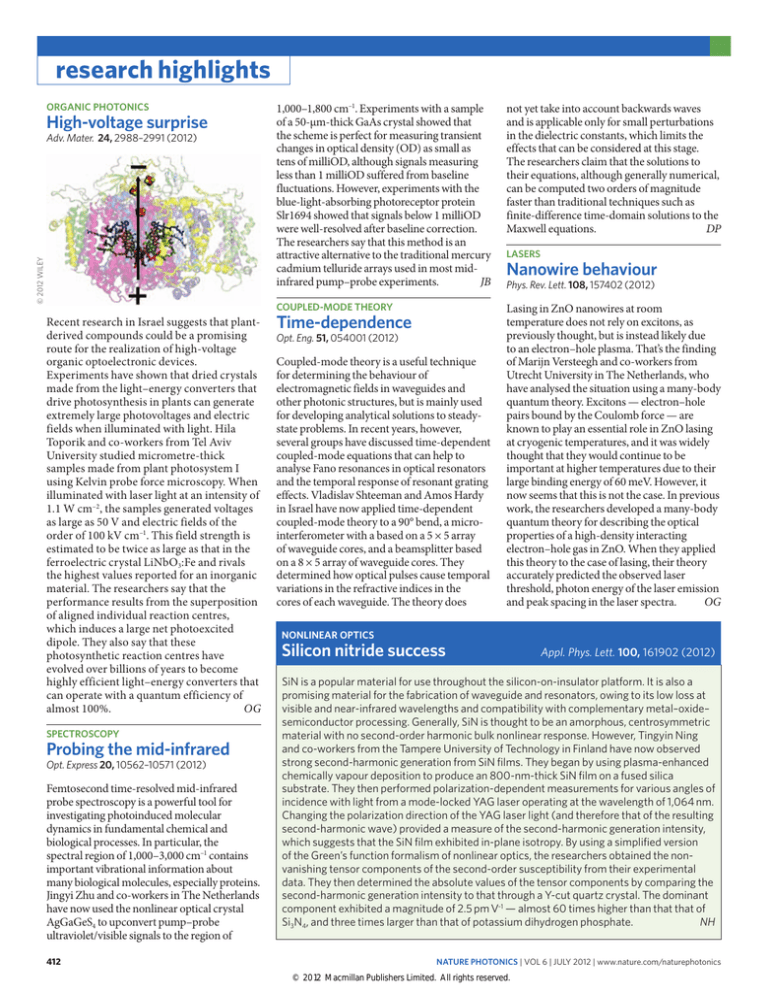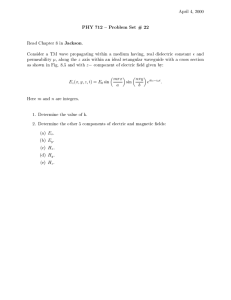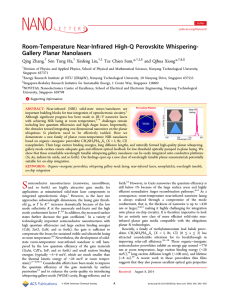
research highlights
ORGANIC PHOTONICS
High-voltage surprise
© 2012 WILEY
Adv. Mater. 24, 2988–2991 (2012)
Recent research in Israel suggests that plantderived compounds could be a promising
route for the realization of high-voltage
organic optoelectronic devices.
Experiments have shown that dried crystals
made from the light–energy converters that
drive photosynthesis in plants can generate
extremely large photovoltages and electric
fields when illuminated with light. Hila
Toporik and co-workers from Tel Aviv
University studied micrometre-thick
samples made from plant photosystem I
using Kelvin probe force microscopy. When
illuminated with laser light at an intensity of
1.1 W cm–2, the samples generated voltages
as large as 50 V and electric fields of the
order of 100 kV cm–1. This field strength is
estimated to be twice as large as that in the
ferroelectric crystal LiNbO3:Fe and rivals
the highest values reported for an inorganic
material. The researchers say that the
performance results from the superposition
of aligned individual reaction centres,
which induces a large net photoexcited
dipole. They also say that these
photosynthetic reaction centres have
evolved over billions of years to become
highly efficient light–energy converters that
can operate with a quantum efficiency of
almost 100%.
OG
SPECTROSCOPY
Probing the mid-infrared
Opt. Express 20, 10562–10571 (2012)
Femtosecond time-resolved mid-infrared
probe spectroscopy is a powerful tool for
investigating photoinduced molecular
dynamics in fundamental chemical and
biological processes. In particular, the
spectral region of 1,000–3,000 cm–1 contains
important vibrational information about
many biological molecules, especially proteins.
Jingyi Zhu and co-workers in The Netherlands
have now used the nonlinear optical crystal
AgGaGeS4 to upconvert pump–probe
ultraviolet/visible signals to the region of
412
1,000–1,800 cm–1. Experiments with a sample
of a 50-μm-thick GaAs crystal showed that
the scheme is perfect for measuring transient
changes in optical density (OD) as small as
tens of milliOD, although signals measuring
less than 1 milliOD suffered from baseline
fluctuations. However, experiments with the
blue-light-absorbing photoreceptor protein
Slr1694 showed that signals below 1 milliOD
were well-resolved after baseline correction.
The researchers say that this method is an
attractive alternative to the traditional mercury
cadmium telluride arrays used in most midinfrared pump–probe experiments.
JB
not yet take into account backwards waves
and is applicable only for small perturbations
in the dielectric constants, which limits the
effects that can be considered at this stage.
The researchers claim that the solutions to
their equations, although generally numerical,
can be computed two orders of magnitude
faster than traditional techniques such as
finite-difference time-domain solutions to the
Maxwell equations.
DP
COUPLED-MODE THEORY
Lasing in ZnO nanowires at room
temperature does not rely on excitons, as
previously thought, but is instead likely due
to an electron–hole plasma. That’s the finding
of Marijn Versteegh and co-workers from
Utrecht University in The Netherlands, who
have analysed the situation using a many-body
quantum theory. Excitons — electron–hole
pairs bound by the Coulomb force — are
known to play an essential role in ZnO lasing
at cryogenic temperatures, and it was widely
thought that they would continue to be
important at higher temperatures due to their
large binding energy of 60 meV. However, it
now seems that this is not the case. In previous
work, the researchers developed a many-body
quantum theory for describing the optical
properties of a high-density interacting
electron–hole gas in ZnO. When they applied
this theory to the case of lasing, their theory
accurately predicted the observed laser
threshold, photon energy of the laser emission
and peak spacing in the laser spectra.
OG
Time-dependence
Opt. Eng. 51, 054001 (2012)
Coupled-mode theory is a useful technique
for determining the behaviour of
electromagnetic fields in waveguides and
other photonic structures, but is mainly used
for developing analytical solutions to steadystate problems. In recent years, however,
several groups have discussed time-dependent
coupled-mode equations that can help to
analyse Fano resonances in optical resonators
and the temporal response of resonant grating
effects. Vladislav Shteeman and Amos Hardy
in Israel have now applied time-dependent
coupled-mode theory to a 90° bend, a microinterferometer with a based on a 5 × 5 array
of waveguide cores, and a beamsplitter based
on a 8 × 5 array of waveguide cores. They
determined how optical pulses cause temporal
variations in the refractive indices in the
cores of each waveguide. The theory does
LASERS
Nanowire behaviour
Phys. Rev. Lett. 108, 157402 (2012)
NONLINEAR OPTICS
Silicon nitride success
Appl. Phys. Lett. 100, 161902 (2012)
SiN is a popular material for use throughout the silicon-on-insulator platform. It is also a
promising material for the fabrication of waveguide and resonators, owing to its low loss at
visible and near-infrared wavelengths and compatibility with complementary metal–oxide–
semiconductor processing. Generally, SiN is thought to be an amorphous, centrosymmetric
material with no second-order harmonic bulk nonlinear response. However, Tingyin Ning
and co-workers from the Tampere University of Technology in Finland have now observed
strong second-harmonic generation from SiN films. They began by using plasma-enhanced
chemically vapour deposition to produce an 800-nm-thick SiN film on a fused silica
substrate. They then performed polarization-dependent measurements for various angles of
incidence with light from a mode-locked YAG laser operating at the wavelength of 1,064 nm.
Changing the polarization direction of the YAG laser light (and therefore that of the resulting
second-harmonic wave) provided a measure of the second-harmonic generation intensity,
which suggests that the SiN film exhibited in-plane isotropy. By using a simplified version
of the Green’s function formalism of nonlinear optics, the researchers obtained the nonvanishing tensor components of the second-order susceptibility from their experimental
data. They then determined the absolute values of the tensor components by comparing the
second-harmonic generation intensity to that through a Y-cut quartz crystal. The dominant
component exhibited a magnitude of 2.5 pm V–1 — almost 60 times higher than that that of
Si3N4, and three times larger than that of potassium dihydrogen phosphate.
NH
NATURE PHOTONICS | VOL 6 | JULY 2012 | www.nature.com/naturephotonics
© 2012 Macmillan Publishers Limited. All rights reserved.






